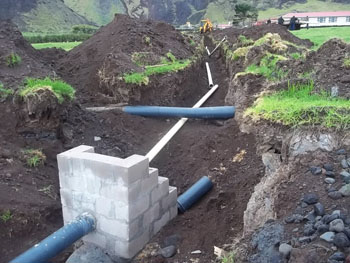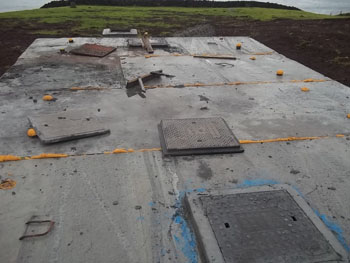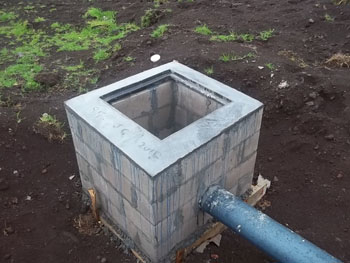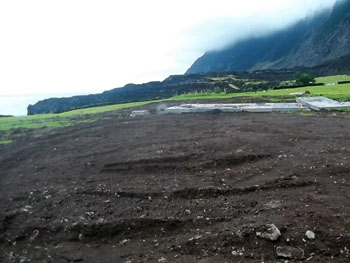Tank Farm Project Completed
Report from PWD Director Mike Wolfenden
|
The Public Works Department (PWD) are pleased to announce that the Tank Farm project is complete. It consists of nine static fuel tanks, twenty supporting plinths, two retaining concrete sumps, three sets of concrete steps and two control valves. The frontal access towers are built and connected by catwalks with sand landscaping around the exterior of the sumps to assist drainage in bad weather.
The project was delayed many times by the unseasonal late and very wet spring, which restricted concrete mixing and pouring. The reinforced retaining walls required 638 m2 of bespoke shuttering , 90m3 of reinforced concrete fill as well as 115m3 of floor concrete screed to produce a ‘flow to valve’ contour essential to evacuate rain water or diesel if there should ever be a burst tank. The two blue gate valve assemblies are robust and when assembled weigh 50 Kgs plus, each. There is one per concrete dish and were cast in reinforced cement jackets as shown in the picture left. The towers and catwalks are galvanised steel and designed to resist the almost constant salt laden breezes which constantly brush the island. |
|
The farm has 9 tanks, each capable of holding 23,000 litres of fuel, each are filled to 20,000 to allow air spaces for climate and pressure changes. The farm can hold 180,000 litres, approximately equal to 180 cubic meters (m3) or say six articulated road trucks of 30,000 litres each. The Edinburgh discharged approx. 70,000 litres during its November 2015 visit so the diesel farm always holds at least two thirds of its total capacity needed to sustain the island grid and power the Fish Factory.
Photos from Barry Davies
|
|
|
Photos taken on 13th November 2015
when the project was officially completed
Shown in both photos above are PWD Director Mike Wolfenden (with cap), Administrator Alex Mitham and Enviroconsult's Tristan Station Manager Hubert Launay (2nd left) with, in the left photo Clerk of Works Barry Davies and in the right photo Finance Officer Chris Standing.
Right: Mike Wolfenden presents Hubert Launay with a French Bean plant at the plant (as they say), with Chris Standing behind.
|
|
|
Administrator Alex Mitham adds:
The new Diesel Tank Farm is a huge achievement for the Island. It overhauls the previous (military/islanders) installed farm which was over 50 years old. The new system delivers an increased holding capacity and now adheres to modern specifications.
Tristanians from across different departments helped to construct the new farm with Joe Green and Keith Green leading the two teams. We had hoped to construct the new farm last year, but were unable to do so due to the multitude of other projects and weather problems. However the Island pulled together and delivered the new farm within 5 months. This new tank farm should be with us for several decades and provides a low maintenance fuel holding source to feed all our power needs - including the factory and CTBTO premises.
I would like to thank all the Islanders involved in the construction as well as Ovenstone and CTBTO in working together to deliver the new Tank Farm.
|
Photo showing left Team Leader Keith Green
and right co-worker Eugene Repetto
with
Mike Wolfenden on 12th November
as work on the tank farm drew to a close. |
See below report and photos of the earlier construction phase of the project. |
| |
Overview of the 2014-2015 Sewage Project from Robin Repetto
See also Tristan's Water Supply and Sewage System Page with historical information and recent work reports and photos
Due to the old septic tanks being structurally damaged, and not performing as they should, it was decided to build two new septic tanks. These would be built to a higher capacity to accommodate the change in the village growth since the installation of the previous septic tanks built pre 1961.
The sewage project started on the 9th October 2014 and Victor Cinamon MCIOB PrCM MIQ was contracted to visit Tristan and supervise the construction of the new sewage and septic tanks. These were designed with a single dividing wall and two containment areas. A soak away was constructed to maximise the coverage of drainage and to minimise the disruption to the grazing within the field.
Some pipe work was renewed within the village area, as these were made from old pitch fibre, but not all could be changed as the scope of work would be too large.
Flow meters were used to determine the amount of water consumed by the community to justify the size to build the tanks. The new sewer system would be gravity driven, with sewage being piped into the two new separate septic tanks. Built in the “American fence” they are situated at the lower slopes of the settlement. These tanks require no pumps, settling ponds, drying sites and no mechanical dependence, nature doing all the work of breaking everything down. The new tanks were situated as close to the existing old tanks as possible so new piping could be transferred over quite easily, without any disruption.
A huge thanks to all who contributed in working on the water, sewage and also the electrical projects. Your participation was greatly appreciated. |
Photos from Drew Campbell
|

|

|
Pipe and manhole installation |
Septic tank with pre cast panels nearing completion |

|

|
Manhole construction |
Area levelled around septic tank to allow pasture to re-grow |
Building New Tank Farm
Photos from PWD Director Drew Campbell |
|
|
Rusted state of the old diesel tanks
|
Casting of concrete base to the new tank farm |
New tank ready to be installed in July |
|